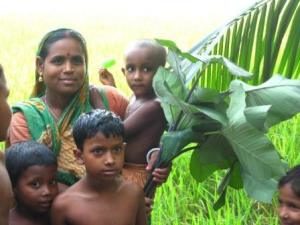
Bangaldesh. Photo: IFPRI, A. Quisumbing
Gender research is still sparse for gender and aquaculture, fisheries and the coasts. Gender studies are a little further advanced in agriculture and natural resource management. Very useful resource materials can be found from the work of the International Food Policy Research Institute (IFPRI), one of the CGIAR Centers. Here are 5 links to IFPRI resources on gender and development.
1. Gender Toolbox: https://www.ifpri.org/publication/gender-tool-box
Includes links to many valuable and essential analytical tools and sex-disaggregated databases and gender-sensitive databases.
2. Gender and collective action: http://www.ifpri.org/sites/default/files/publications/CAPRIWP64.pdf
CAPRI working paper, 2007, by Lauren Pandolfelli, Ruth Meinzen-Dick and Stephan Dohrn
‘This paper presents a framework for investigating the intersection of collective action and gender; i.e. how gender-oriented analysis can foster more effective collective action in the context of agriculture and natural resource management and how collective action can be used as a vehicle for gender equity. We begin with definitions of the key concepts and then present three entry points for a gendered analysis of collective action-motivations, effectiveness, and impact on gender equity- vis-à-vis the Institutional Analysis and Development (IAD) framework (Oakerson 1992; Ostrom 1991). At the heart of this framework is the action arena, which is shaped by a host of initial conditions, including asset endowments, vulnerabilities, and legal and governance systems that influence a range of outcomes. Applying a gender lens to this framework, we present an analysis of how women and men experience the initial set of conditions differently and thus, have different motivations and capacities for engaging in collective action. Next, we look at how the gender composition of groups affects the effectiveness of collective action, and finally, at the impact of collective action on gender equity and women’s empowerment. We conclude with a discussion of how this framework can improve our understanding of gender and collective action in order to facilitate more effective collective action while fostering gender equity.’
3. Engendering agriculture and agricultural research: http://www.ifpri.org/publication/engendering-agricultural-research
By Ruth Meinzen-Dick, Agnes Quisumbing, Julia Behrman, Patricia Biermayr-Jenzano, Vicki Wilde, Marco Noordeloos, Catherine Ragasa, and Nienke Beintema
‘This paper makes a case for gender equity in the agricultural R&D system. It reviews the evidence on exactly why it is important to pay attention to gender issues in agriculture and why it is necessary to recognize women’s distinct food-security roles throughout the entire value chain—for both food and nonfood crops, marketed and nonmarketed commodities. The authors examine whether women are factored into the work of research institutions, and whether research institutions effectively focus on women’s needs. In short, are these institutions conducting research by and for women? The paper’s conceptual framework demonstrates the need to integrate gender into setting agricultural priorities; conducting the research itself; designing, implementing, and adopting extension services; and evaluating their impacts. It concludes with recommendations regarding how to make these suggested changes.’
4. IFPRI’s work on gender and development: http://www.ifpri.org/book-20/ourwork/researcharea/gender
IFPRI’s main webpage giving a guide to their gender work and related resources.
5. IFPRI’s contributions to the World Development Report 2012 on Gender Equality and Development: Gender Equity and Development: http://www.ifpri.org/blog/gender-equality-and-development
This entry was posted in: Aquaculture, Bangladesh, Freshwater Fisheries, Gender, Marine Fisheries, Men, Women
